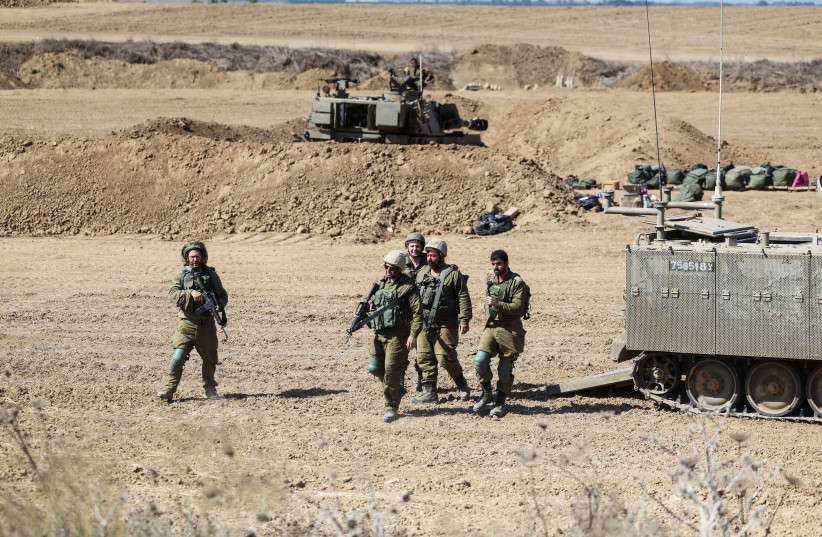All signs are that Israel will shift from the “main war” (Stage 2) to a longer, lower-intensity conflict in Gaza (Stage 3) in the next two to four weeks.
What will this mean? To answer that question, we need to identify why this is happening.
There are two main reasons this is happening: 1) world pressure and, most importantly, American pressure, and 2) pressure from reservists and their families to be able to return to regular life.
The Jerusalem Post has learned that balancing between these two reasons will be the key to navigating this incredibly important transition.
At a minimum, at a practical level, the transition means that hundreds of thousands of reservists may be returning home from Gaza and the northern front in the near future.

Not all of the reservists, and many of the reservists, will need to rotate in and out of the southern and northern fronts for longer than usual reserve duty stints in 2024.
Reduced number of IDF reservists in the field
But if the IDF jumped from a military of 100,000-150,000 before the war to around 450,000 at the climax of reservists volunteering, it is going to drop much closer to the pre-war levels (though not all the way back down.)
This already started a few weeks ago when much of IDF Division 252, a mostly reservist division, was given extended leave after finishing certain missions in northern Gaza.
It will progress more dramatically in the near future.
This is happening because, socio-economically, the country is not built to survive with reservists at war for months straight at a time.
The toll it takes on the economy from missing workers and the toll it takes on families from missing parents is immense and cumulatively starts tearing at the foundation of the country even more as time passes.
It is happening because the reservists and their families represent a massive voting constituency that no one wants to alienate by keeping them in service longer than they believe is fair, even during wartime.
The Post has learned that the IDF is also very concerned about giving the reserves breathing room in a much larger way than it has done to date.
But that is only half of the story.
The other half of the story is pressure from Israel’s EU allies, Sunni allies, and its most critical ally in Washington.
Global pressure to shift war to low-intensity
The Post understands that even if the government and the IDF do not see themselves as officially beholden to the US and are capable of saying “no” to American requests on certain fundamental military issues, they are greatly concerned about maintaining Washington’s support.
This is crucial not just for vetoing one-sided resolutions at the UN but also for actual massive and ongoing military resupply of offensive munitions and defensive weapons, as well as whether Iran, Hezbollah, and Hamas view Jerusalem as backed or not backed by a juggernaut.
If reducing reservists will limit the number of troops in the field in Gaza and in the North to much less than the current number, to retain American support, Stage 3 will need to see fewer air strikes, tanks, and large-scale casualty stories.
America is never happy when a mistaken IDF airstrike kills a significant number of civilians. But to some extent, the Biden administration has swallowed these incidents as long as the main war was going on so they could say to the Israeli government that they were given plenty of time to invade Gaza in a big way.
The rough compromise struck between Israel and the US was that instead of finishing the main, heavier-on-airstrikes and tanks war by December, the IDF could have until mid to late January.
How will these changes impact the IDF’s ability to complete the goals of dislodging Hamas and returning the remaining 129 hostages?
Just as Israel settles in for a longer low-intensity conflict with Hamas, will the Gaza terror group rally from seeing that there are fewer troops and air strikes?
If it becomes clearer that Israel’s main war has ended and the perception is that it has no real deadline or set game plan for killing Hamas’s leaders without also losing large numbers of hostages in the crossfire, will Hamas – paradoxically currently at its lowest point – breathe in new life to resist for that much longer?
And if the IDF sees this process happening, will it be willing to bring back airstrikes and risk re-upsetting the US and other allies, or if the primary goal of Stage 3 is to keep American support, will the military simply have to deal with a newly “pumped up” Hamas?
Many of the answers to these questions are not yet clear because Israel and the IDF do not know how they want the current war and post-war to end with Hamas.
The longer Israel does not provide itself with clear answers, the more likely Hamas and other Israeli adversaries can take advantage.
